 |
| Category:1st AIF |

|
This page is a sub
category index |
|
|
|
|
World War I -
Gallipoli-Overview
|
| The campaign was
launched on 25 April 1915 when two landings were made. One was the
a 35,000-strong British main force led by Lieutenant General
Hunter Weston and the other a 17,000-strong support force
comprising men from the Australian and New Zealand Army Corps
(ANZAC) under General William Birdwood. |
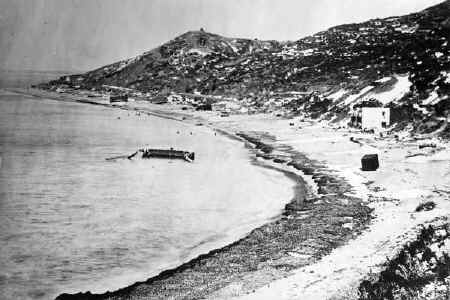 |
| Snow on Anzac
Cove. We sometimes forget how cold Gallipoli was in winter
and how hot in summer. |
|

Sub category index
|
|
Australian
casualties for the campaign were 26,111, comprising 1007 officers and
25,104 other ranks. Of these, 362 officers and 7779 men (total
8,141) were killed in
action, died of wounds or succumbed to disease.
|
|
While still training in the Egyptian
desert late in 1914, the 1st Australian Division and the New Zealand and
Australian Division (NZ and A Division) (which later included the 1st
Light Horse Brigade) were formed into the Australian and New Zealand
Army Corps (ANZAC), under the command of Lieutenant General William R
(Field Marshal, Lord) Birdwood.
Together with British troops, the
ANZAC forces had been kept in Egypt because of unsuitable training
facilities in England and, later, to help protect the Suez Canal,
following Turkey’s entry into the war in October 1914.
In the face of lack of progress on the
Western Front in late 1914, the British War Council suggested that
Germany could best be defeated by attacks on her weaker allies,
Austria-Hungary and Turkey.
Initially, the attack on Turkey was to be a
naval operation but, after abortive naval attempts to force the
Dardanelles in February and March, the British Cabinet agreed that land
forces could be used.
The ANZACS, together with British formations,
landed north of Gaba Tepe (the landing area later known as Anzac Cove)
and at Cape Helles on the Gallipoli Peninsula.
 Click here for more
Click here for more
|
 |
| A Gallipoli character as drawn Mike Chappell
in the Osprey Publications book The Australian Army at War 1899-1975.
ISBN 0-85045-418-2 |
 |
ANZAC Terrain
This image gives a clear
indication of the sort of terrain that the Diggers faced and that helped
the Turks mount a successful defence.
It also indicates the
difference that landing
1 to 1˝ miles further north made to the chances that the Anzacs had. The
image is from Gallipoli by Les Carlyon ISBN 0-7329-1128-1 |
|
They were to capture the
Turkish forts commanding the narrow straits and force open the way to
the Turkish capital, Constantinople.
French forces attacked the Turkish
positions on the Asia Minor side of the Dardanelles.
Later
reinforcements included the dismounted Australian Light Horse and New
Zealand Mounted Brigades at Anzac Cove and another British corps at
Suvla Bay.
The campaign was an heroic but costly
failure. In December, it was decided to evacuate the entire force from
Gallipoli.
On 19 and 20 December, the evacuation of Anzac and Suvla was
completed with the last British troops leaving Cape Helles by 8 January
1916.
The entire operation evacuated 142,000 men with negligible
casualties.
Map of the "Suvla Plan" from
Gallipoli by Les Carlyon ISBN 0-73291128-1
>>> |
 |
|
Pages about ANZAC |
|
Click the images to
go to those pages. |
 |
 |
| The
Anzac Book, edited by CEW Bean, 1915 |
The
Anzac Story for boys & girls by TA Miles |
|
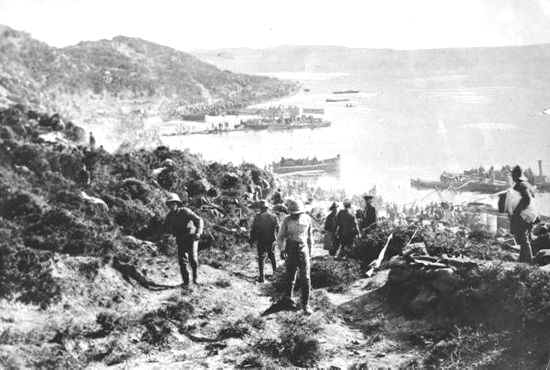
|
|
New Zealand and Australian
soldiers landing at Anzac Cove, 25 April 1915. |
|
|

|
|
Field Hospital at Ocean Beach,
Gallipoli. Photograph taken by E.N. Merrington.
|
- The Gallipoli operation cost
Australia 26,111 casualties, 8,141
dead,
- New Zealand 7,571 casualties, 2,431
dead,
- Britain 120,000 casualties, 21,255
dead,
- France 27,000 casualties, 10,000
dead,
- India 1,350
dead,
- Newfoundland (now part of
Canada) 49
dead.
|
Gallipoli Casualties KIA, (DVA figures)
| Turkey |
|
Pte B. Jackson, 2nd Battalion,
day of Armistice, 24th May...."I came to a spot where the
dead were lying two and three deep, and I saw an
Australian and a Turk who had run each other through with
their bayonets. (they) had fallen dead at the same instant, as
their bayonets had not been withdrawn. In their death struggle
, their arms must have encircled each other. They had
been in that sad embrace for at least a week".
|
| Britain |
21,255 |
| France |
9,798 |
| Australia |
8,709 |
| New Zealand |
|
| India |
1,358 |
| Newfoundland |
|
|
 |
Troops at
Anzac taking a short break from the front line to chat. Chatting was not
"having a yarn" although it is possible that that is the way
the term started. Chatting was searching through your clothes to find
and kill the chats, small lice like insects that infected everyone at
Anzac and many in France/Flanders. Photo
Gwen Ladner |
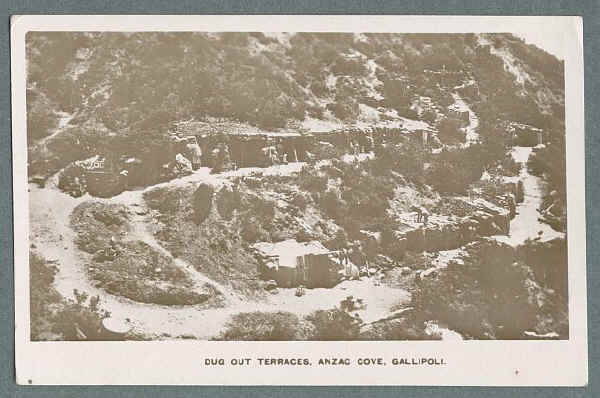 |
|
Dug out terraces at
Anzac Cove Gallipoli |
|
No grenades? Make your own
! "Jam-tin bombs" |
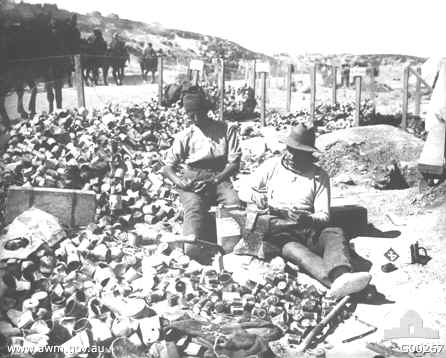 |
Gallipoli
Peninsula, Turkey. 1915.
Two soldiers sit beside a pile of empty tins
cutting up barbed wire for jam tin bombs. The bombs were made near the
beach, a spot popularly known as the 'bomb factory' near Anzac Cove. All
the old jam tins and other used containers were used to make bombs which
were then filled with fragments of Turkish shells and enemy barbed wire
which had been cut into small lengths.
|
|
The Newspaper that got
shot. |
 |
This rolled Newspaper was
shot at Gallipoli and still carries the bullet.
<<< Click to enlarge |
| Addressed
to Gunner J Talmage, No.2900, First Australian Expeditionary Force.
Posted in Melbourne Australia, September 1915 and "shot" at
Gallipoli. (Possibly 2905 James Talmadge, Field
Artillery Brigade who RTA as a Sergeant) |
|
THE REAL ANZACS |
|
There are plenty of
slouch-hatted soldiers in town,
Doughty and debonair, stalwart and brown;
Some are from Weymouth or Salisbury plain,
Others have 'pushed' in the western campaign;
Call them 'overseas soldiers'
or 'down-under men'
Declare that each is as daring as ten;
Call them cornstalks or fern leaves all out for a fight,
But don't call them ANZACS, for that isn't right.
The ANZACS, their ranks are scanty but all told,
Have a separate record illuminated in gold;
Their blood on Gallipoli's ridges they poured,
Their souls with the scars of that struggle are scored,
Not many are left, and not
many are sound,
And thousands lie buried in Turkish ground,
These are the ANZACS; the others may claim,
Their zeal and their spirit, but never their name.
by an unknown Aussie soldier.
|
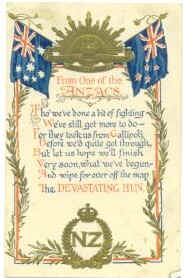
|
- From One of The Anzacs
- 'Tho we've done a bit of
fighting
- We still got more to do
- For they took us from
Gallipoli
- Before we got quite through
- But let us hope we'll finish
- Very soon, what we've begun
- To wipe forever off the map
- The Devastating
Hun.
|

|














